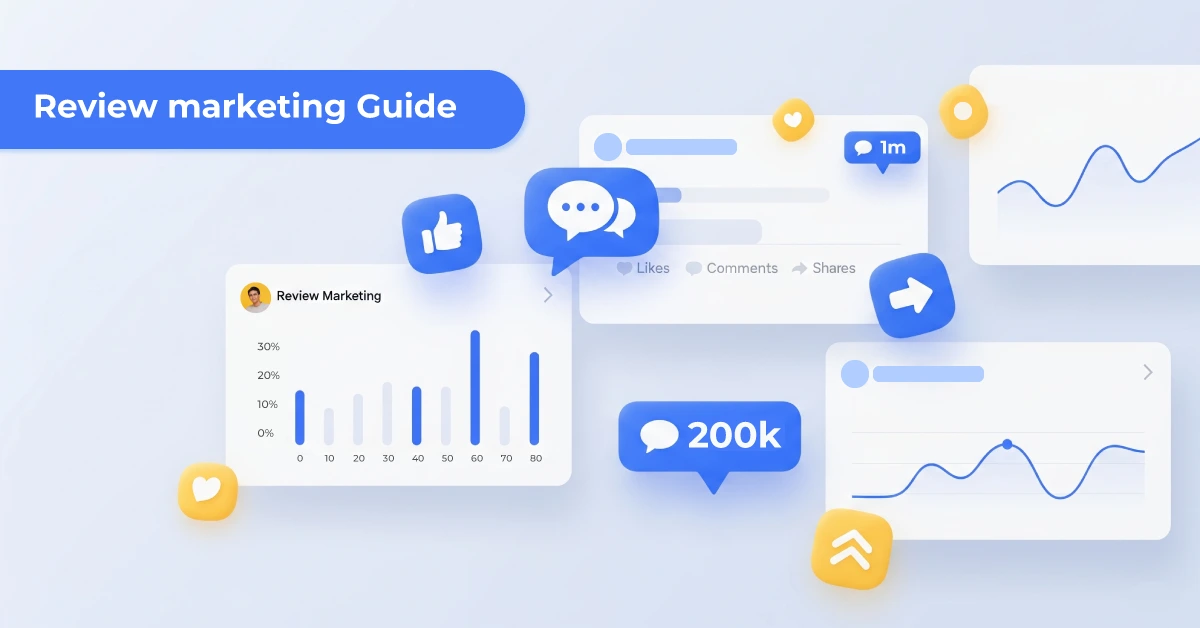Most businesses know customer reviews are important – but do you realize how important? Here is a perfect scenario: you’re choosing between two new restaurants in town.
One has a 4.8-star rating with 487 glowing Google reviews, the other has 3 stars with just a dozen reviews – half of them negative. Which would you try first?
In my experience, and likely yours too, the one with stellar feedback wins every time. That is the power of review marketing in action.
In this guide, we’ll explore what review marketing is and why those little stars and comments matter so much. I’ll share tips, examples, and a few cautionary tales along the way. Let’s dive in!
What is Review Marketing?
Review marketing is the strategy of leveraging customer reviews and testimonials as a marketing asset. It goes beyond simply having reviews – it means actively using authentic feedback from your customers to promote your business, build trust, and influence new buyers.
In essence, it turns satisfied customers into your brand ambassadors. For example, featuring a “5-star: Excellent service, will buy again!” quote from a happy customer on your homepage or social media is review marketing at work.
Why Customer Reviews Matter
Customer reviews are often a make-or-break factor for consumers. Let’s find out why they matter so much:
- Trust and Credibility: Reviews serve as instant social proof. People tend to trust the experiences of other customers as much as personal recommendations from friends. In fact, 84% of people trust online reviews as much as a personal referral.
- Influence on Buying Decisions: Reviews have a direct impact on whether customers click “Buy” or walk away. An overwhelming 93% of consumers say online reviews impact their purchase decisions. I’ll admit – I’m part of that 93%.
In a nutshell, customer reviews have become the backbone of consumer trust. If you’re not actively encouraging and utilizing reviews, you’re leaving money on the table and customers in the dark.
Psychology Behind Review Marketing
Why exactly do people put so much stock in strangers’ opinions online? It comes down to a few key psychological principles:
- Social Proof: Humans are social creatures; we tend to follow the crowd when uncertain. Seeing that “hundreds of others” have had a positive experience creates an implicit trust. The mindset becomes “If others like it, it must be good.”
- Confirmation Bias: People generally look for information that confirms what they want to believe. If someone is already interested in your product, they’ll gravitate toward reviews that validate that interest.
- FOMO (Fear of Missing Out): When a product or service has a ton of buzz and positive reviews, people naturally fear missing out on something great. This is tied to the bandwagon effect – if everyone’s raving about Product X, you start wondering if you should try it too.
These psychological factors make reviews incredibly persuasive.
How to Successfully Collect Customer Reviews
Alright, so reviews are clearly gold. But how do you get more of them? Here is how to maximize your review volume and quality:
Timing and Methods for Requesting Reviews
Timing is everything when asking for reviews. The best moment to request a review is when the experience is fresh and the customer is happiest. I am talking about immediately after a purchase or service delivery (especially if you’ve just solved their problem or exceeded their expectations).
Some effective channels and methods include:
- Sending a personalized post-purchase email with a direct review link.
- For a more immediate touch, SMS review requests can work wonders. People tend to read texts almost instantly.
- If you have a physical location or printed materials, take advantage of them. For example, include a QR code on receipts, product packaging, or signage that says “Scan to Leave a Review”.
- A quick DM on social media or a follow-up phone call (for high-touch services) saying “It was a pleasure serving you. If you don’t mind, could you share a brief review?” can feel very flattering to the customer.
- If you have a software product or app, timing an in-app popup to ask for a rating after a positive user action is common.
The key across all methods is to keep it simple and make it convenient. Provide direct links (no one wants to hunt around for where to review) and be polite in your wording.
Incentivizing Reviews (Ethically and Legally)
Consumers are increasingly becoming aware; about 67% of consumers are concerned about review fraud on platforms.
What’s allowed, and what’s not? Generally speaking, bribing people for positive reviews is a big no-no. The U.S. Federal Trade Commission (FTC) recently finalized rules outright banning the sale or purchase of fake reviews or any reviews not based on real experiences.
The FTC explicitly says if you do offer an incentive for a review, you cannot condition it on being positive, and the reviewer must disclose they got an incentive.
So how can you ethically encourage reviews? A few best practices:
- Small “Thank You” gestures
- Loyalty programs and follow-up
- Provide great service (the “natural incentive”)
- Don’t pressure or guilt-trip
- Never fake it
One more note: if you do provide any incentive (like a small coupon) for leaving a review, be transparent about it.
Tools and Platforms for Efficient Review Collection
Manually collecting and managing reviews across the web can quickly become overwhelming. Thankfully, there are tools and platforms I have compiled to help streamline the process.
Here are some of the top platforms and software solutions for generating and aggregating customer reviews (and how to use them to your advantage):
- Krofile: Krofile is an all-in-one digital business card that makes it super easy to collect and showcase reviews. Think of it as a centralized hub where customers can find all your info and leave feedback in one spot.

- Google Business Profile: When it comes to local reviews, Google is king. Google reviews (via your Google Business Profile) are often the first thing people see when they search your business.
- Trustpilot: Trustpilot allows any customer to review a business on their site, and those reviews often show up in search results (Trustpilot pages rank well).
- Podium: Podium is a customer interaction platform known for its SMS-based review invites and messaging.
- Other Niche Platforms: Depending on your industry, there are specific platforms to focus on. For example, Yelp is critical for restaurants and home services in many cities. TripAdvisor is huge for hotels, attractions, and tour operators. Avvo for lawyers, Zillow for real estate agents, G2 and Capterra for B2B software.
Also read: 8 Review Generation Tools to Boost Your Business in 2025
Leveraging Customer Reviews in Your Marketing Strategy
Collecting a bunch of great reviews is wonderful – but review marketing doesn’t stop at collection. Let’s explore how to showcase and deploy reviews for maximum impact:
Displaying Reviews Effectively
If you’ve got them, flaunt them! Displaying reviews prominently and strategically can significantly boost conversions and user trust on the spot. Here are some best practices for featuring reviews on various channels:
- On Your Website: Your own website is prime real estate for showcasing customer love. Don’t relegate reviews to a hidden subpage; instead, sprinkle them throughout key pages. On product pages, include star ratings and excerpts of top reviews near the product title or price. Consider a dedicated “Testimonials” or “Customer Stories” page as well, especially for service businesses – but don’t be afraid to “overdo” it a bit on landing pages.
For instance, Basecamp (the project management SaaS) famously packed its homepage with multiple testimonial elements: a quote right below the headline, then further down a carousel of customer stories.

They prove that if you have great feedback, you can layer it in various formats (text blurbs, star ratings, even customer photos or videos) for credibility at every turn.
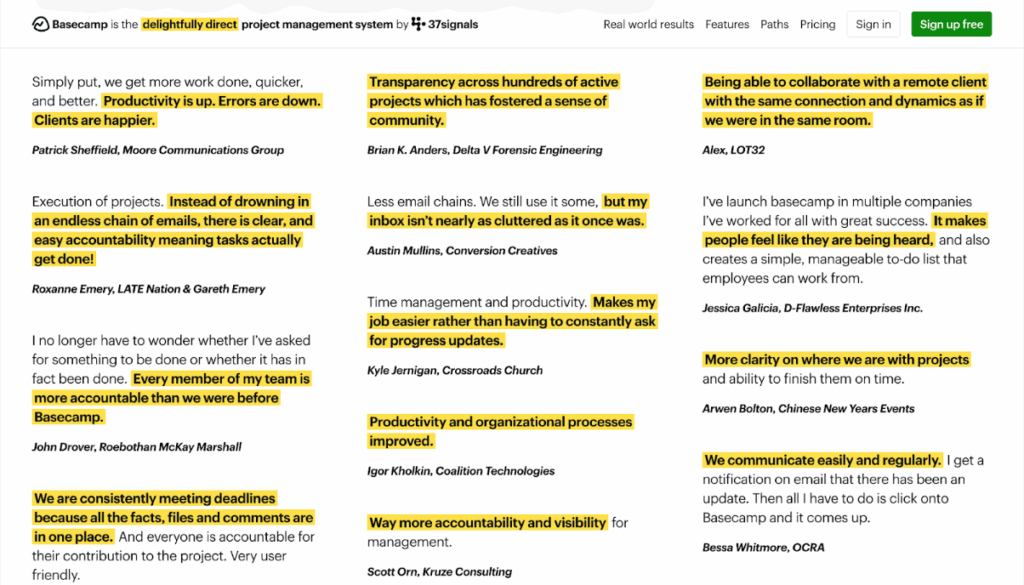
- Visual Elements: Make your review displays eye-catching. Use star icons (those ⭐⭐⭐⭐⭐ instantly grab attention and communicate sentiment without words). If a customer provided a photo with their review, feature it – real customer photos add authenticity.
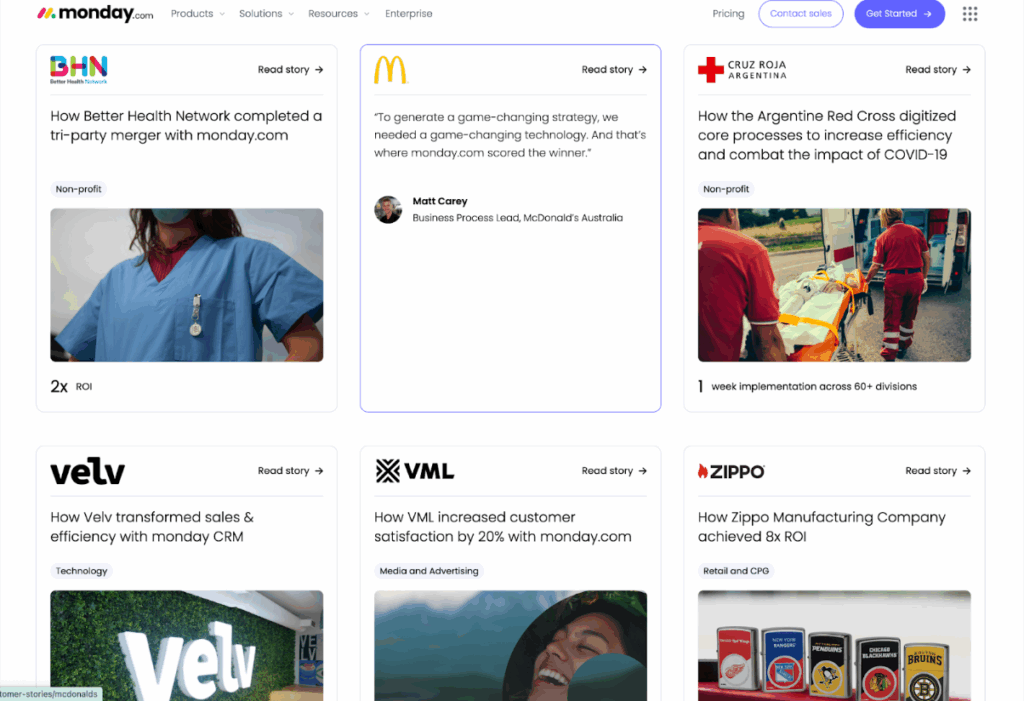
- Social Media: Reviews can be repurposed as fantastic social media content. You can create a series of customer testimonial posts – for example, take a compelling one-liner from a review and overlay it on a photo (maybe a user-generated image of your product in use, or a nice background), and post it with a caption like “We love hearing feedback like this from our customers!”.
- In Email Marketing: If you’re running email campaigns – whether it’s a welcome series, a newsletter, or a promotional blast – consider integrating reviews there too. For example, if you’re highlighting a product in an email, include a short customer quote about that product.
- Real-World Displays: If applicable, showcase reviews in the physical world too. Retail stores have started printing top customer quotes on in-store signage or product tags. Restaurants sometimes print review highlights on menus or boards (especially if a review mentions a specific dish: “Try the tacos – ‘they’re to die for’ according to one Yelp reviewer!”).
Integrating Reviews into Marketing Campaigns
Beyond static displays, think about active ways to leverage reviews in your campaigns and advertising. Reviews can be the secret sauce that makes your marketing messages far more compelling.
Here are some ideas (with examples) on weaving customer reviews into campaigns:
- Social Proof in Ads: Incorporating review snippets or customer ratings into paid ads (Facebook ads, Google search ads, etc.) can significantly improve their performance.
- Retargeting with Reviews: If you’re running retargeting campaigns (ads that show to people who visited your site but didn’t convert), consider serving them an ad that showcases a compelling review.
- Case Studies and Storytelling: If someone leaves a detailed, glowing review about how your product/service helped them, that’s an opportunity to reach out (with thanks) and maybe develop a complete case study or interview.
- Influencer and Partner Amplification: If you notice an industry influencer or respected figure left you a great review, with their permission, you could amplify that: e.g,. feature it in a PR campaign (“See why [Expert Name] recommends our product”) or collaborate on content.
- Review-Based FAQs or Content: If many reviews mention how quick and easy your service is, you might run a campaign around “Get it done in 10 minutes – proven by our customers” and use quotes that mention speed.
Examples of brands excelling in review-based marketing: One real-world example is Amazon, which often features “top reviews” snippets right on the product page and even in some ads. They know those peer opinions drive purchases.

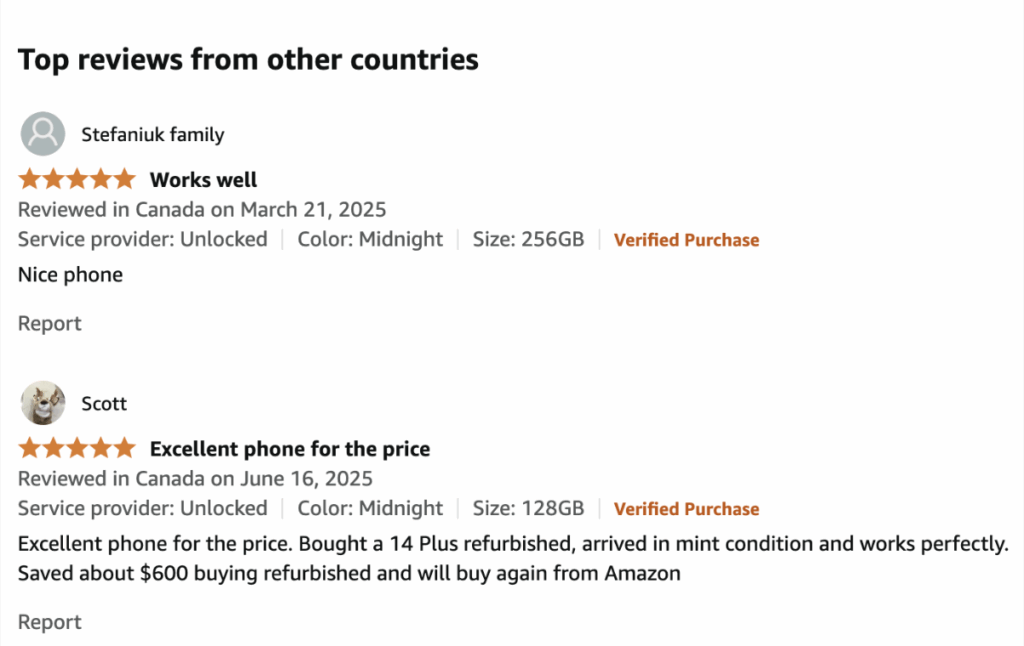
Glossier, a beauty brand, built a lot of its early growth by heavily leveraging customer reviews and feedback on social media – they would often repost customers’ own words about products, making those voices the hero of their marketing.
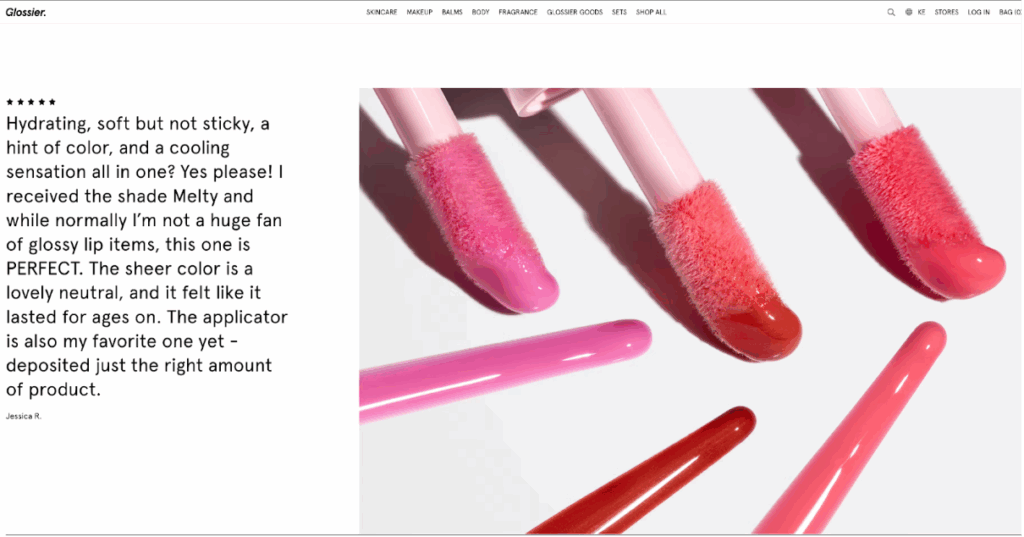
Why Online Review Marketing is Crucial for E-commerce Success
In e-commerce, reviews = social proof = increased sales. Let’s explore how leveraging reviews can specifically boost your online store’s performance:
Enhancing E-commerce Conversion Rates with Reviews
An analysis (by Fera.ai) showed that adding positive reviews can boost conversions by 380% – customers were nearly 4 times more likely to buy when they saw glowing reviews. Essentially, a product page with reviews is far more persuasive than one without.
Visual UGC: Boosting E-commerce Engagement
In e-commerce, visual user-generated content (UGC) – like customer photos and videos – is review gold. Shoppers increasingly want to see real-life usage, not just read about it. Encouraging customers to share images or short videos with their reviews can significantly amplify the impact of the review and boost engagement on your site.
Improving Your Organic SEO with Customer Reviews
Beyond direct conversions and marketing campaigns, customer reviews can also be a secret weapon for your SEO (Search Engine Optimization) efforts. Let’s break down the SEO benefits of a strong review strategy:
Customer Reviews and Local SEO
If you have a local business, know that reviews are a huge part of local SEO. Google’s local search algorithm (which determines who shows up in the “Map Pack” and local results) heavily weighs review signals. In fact, review signals (things like review quantity, review velocity, and average rating) are estimated to account for about 15% of the local ranking factors. That’s significant – nearly one-sixth of what gets you to the top of local search is tied to reviews.
Customer Reviews for Organic Keyword Growth
Customer reviews can help your organic (non-local) SEO in a more subtle but powerful way: they add keyword-rich, long-tail content to your pages. Think about a product page on your website. You might have a description that covers basics, but customers often mention use cases, attributes, and synonyms you never thought of.
Reviews as a Driver for Rich Snippets and Structured Data
Ever notice those eye-catching star ratings that sometimes appear under specific results on Google search? That’s thanks to review rich snippets – a result of structured data markup on your site.
They are not only pleasing to the eye but can dramatically improve your click-through rates from search results.
If you implement the correct Schema markup (a type of structured data) for reviews or aggregate ratings on your pages, Google can display a star rating and sometimes the review count right on your search listing.
Tailoring Review Marketing Strategies Across Industries
Review marketing isn’t one-size-fits-all. Different industries have different customer behaviors and key platforms when it comes to reviews. Let’s explore how review marketing plays out in a few broad categories:
Local and Service-Based Businesses
For local businesses and service providers (think: plumbers, salons, dentists, real estate agents, consultants, etc.), reviews often function as the modern equivalent of word-of-mouth in the community. People are looking for someone they can trust to enter their home, fix their car, care for their health, etc. So your focus should be on building a strong reputation on the platforms locals use to vet businesses.
E-commerce and Retail
For e-commerce and retail brands, you likely have two fronts: your own website and possibly retail platforms/marketplaces (like Amazon, Etsy, etc.). The review strategy needs to cover both, if applicable.
B2B and SaaS Companies
Here, the sales cycles can be longer and the purchase decisions more expensive or complex. Potential buyers are often doing heavy research – and yes, they definitely check reviews and ratings on various platforms as part of that research.
Case studies showing impact:
A great example is how tools like Zoom grew partly by word-of-mouth in the business community – and that includes online reviews on platforms like G2, etc. If you look at Slack’s G2 profile early on, it was loaded with fans, which helped others in IT decide to give it a chance.
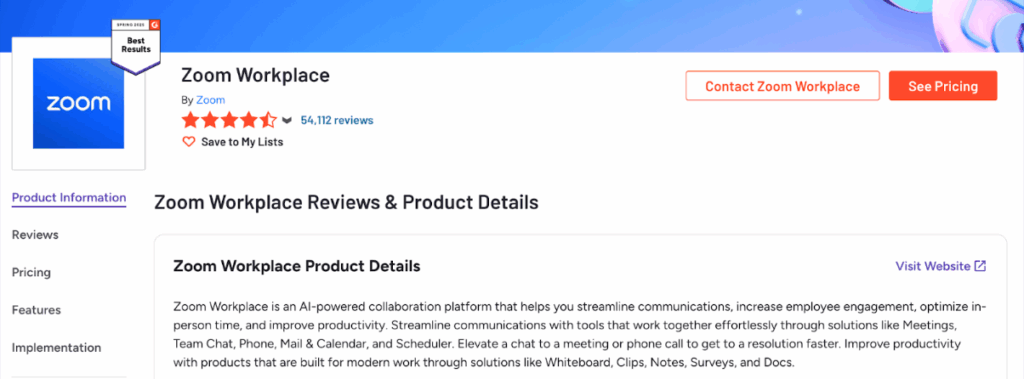
Hospitality and Restaurants
Reviews are critical for hospitality (hotels, B&Bs) and restaurants – this industry arguably lives and dies by reviews and ratings. Travelers and diners heavily rely on others’ experiences when deciding where to go.
One more thing: employee behavior. If you’re in hospitality, remind your staff that everything they do can end up in a review.
Common Pitfalls to Avoid in Review Marketing
While leveraging reviews can work wonders, some pitfalls and mistakes can undermine your efforts. Let’s discuss some common missteps businesses make with review marketing:
Responding Poorly or Not Responding at All
One of the biggest mistakes is to either ignore reviews (especially negative ones) or to respond in a defensive, unprofessional manner. Remember, when a customer posts a review, they’re not just speaking to you. They’re talking to every potential customer who will read that review and your response. Your reply isn’t just customer service, it’s public relations.
Overlooking Review Authenticity
In the quest for shining reviews, some businesses fall into the trap of chasing quantity over authenticity – or worse, trying to game the system with fake reviews. This is a big pitfall that can severely damage your reputation if you’re caught.
It might be tempting to “pad” your ratings by asking friends/family to post glowing reviews or even buying reviews from shady services. Don’t do it!
Measuring the Success of Your Review Marketing Efforts
So you’ve been working hard to gather and leverage reviews – awesome! But how do you know if all this effort is paying off? Let’s break down some key metrics to watch and tools that can help you track and report on your review marketing success.
Key Metrics to Track
- Review Volume and Velocity: Simply, how many reviews are you getting, and how fast?
- Average Star Rating: This is the one everyone sees at a glance – your average rating (out of 5, typically).
- Review Sentiment and Common Themes: It’s not just the stars – what are people saying?
- Traffic and Conversion Metrics: Check your website traffic data – are you getting referral traffic from review sites (e.g., TripAdvisor listing sending traffic to your hotel site, or G2 sending visitors to your signup page)?
- Local SEO & Search Rankings: If part of your goal is improved local visibility, track your Google Maps/Local Pack rankings for key keywords over time as your review profile grows.
- Revenue and ROI: This can be tricky, but you can do things like track average spending per customer now vs. before. If you see store revenue went up after hitting a certain threshold of positive reviews, that’s a correlation to note.
- Customer Satisfaction/Retention: Are your efforts creating happier customers in general? If you do periodic customer surveys or track NPS directly, see if scores align with review trends. Also, retention or repeat purchase rate can be a metric – positive review momentum often goes hand-in-hand with customer loyalty.
Tools for Tracking and Reporting
Thankfully, you don’t have to track all this manually via sticky notes. There are several tools and software options to help gather and make sense of review data:
- Review Management Dashboards: Platforms like Google My Business and Krofile dashboards will show you basic metrics for Google reviews (total, average, recent).
- Analytics Tools: Use Google Analytics or similar platforms to track referral traffic from review sites and engagement with review elements on your site.
- SEO Tools: Tools like Moz Local or SEMrush can help track local rankings and also scrape review data.
- Survey Integration: If you run customer satisfaction surveys (post-purchase, etc.), integrate those with reviews.
- Manual Spot Checks: Perhaps schedule a weekly meeting where you share “Review of the Week” (good or bad) with your team to keep everyone connected to the customer voice.
Ultimately, the success of review marketing shows up in both soft metrics (better customer sentiment and brand perception) and hard metrics (ratings, rankings, revenue).
When you can measure and report those improvements – e.g., “Our average star rating improved from 4.0 to 4.5 in a year, and as a result our click-throughs and sales grew by X%” – that’s powerful evidence that focusing on customer reviews is worth it. I encourage you to pursue it.



